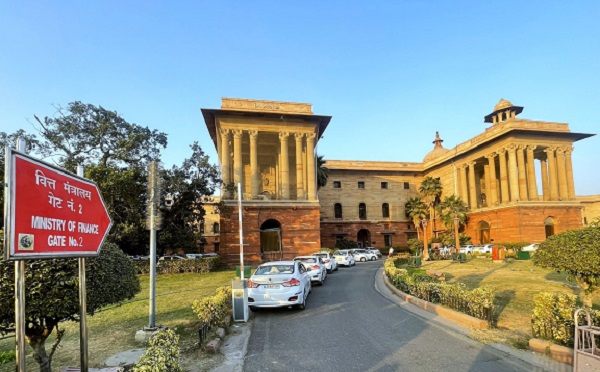.png)

Najib Shah retired as the Chairman of the Central Board of Indirect Taxes and Customs.

Rajesh Mahapatra, ex-Editor of PTI, has deep experience in political and economic journalism, shaping media coverage of key events.
April 14, 2025 at 5:16 AM IST
Despite the unification of multiple indirect taxes such as excise duty, services tax and state-level VAT, and sales tax into a single regime, the GST system has faced several criticisms since its inception in 2017.
Several weeks ago, Finance Minister Nirmala Sitharaman said the government was very close to initiating a major overhaul of the GST regime, but nothing has happened thereafter – not even a word on when the GST Council would meet next.
Meanwhile, developments such as the reciprocal tariffs announced by US President Donald Trump have heightened fears of a global recession. India needs to move fast on insulating its economy and explore all levers of growth.
One such move could be to expeditiously streamline the GST system that could boost business confidence and consumer sentiment.
Pain Points
One of the most prominent pain points has been the multiplicity of tax rates. Initially starting with five main rates (0%, 5%, 12%, 18%, 28%) and later expanding to seven with the addition of two more slabs – 0.25% and 3% for precious stones and gold, respectively - this complex structure has been a constant point of contention.
While the initial rationale behind the varied rates was to balance equity, revenue considerations, and the diverse interests of multiple states, it has led to the perception that the tax is not as simple as promised.
Further exacerbating the complexity are the anomalies within these tax slabs, leading to what appears to be illogical categorisations of similar goods. Examples such as different rates for unpacked, packed, and caramelised popcorn, or packaged paratha versus roti, highlight the lack of a clear rationale in some classifications, which can dent the credibility of the system.
At the same time, it is to be noted that GST is a value-added tax where each stage of value addition is taxed, and credit for earlier taxes is provided, which is why goods of the same kind may attract different rates.
That said, issues like taxing essential goods like water purifiers at a higher rate than potentially less desirable items like bottled water, while consistent with the value addition principle, also point to inconsistencies that perhaps need revisiting.
Moreover, the debate around classifying products such as air conditioners as luxury goods and taxing them at 28% further underscores these anomalies. Similarly, all conventional cars are taxed at 28% along with a cess, while electric vehicles attract a 5% tax and no cess. The rationale is that they do not contribute to pollution, but then the buyers for the latter are relatively more affluent.
Beyond the rate structure, the compliance burden remains a significant pain point, particularly concerning GST registration. Despite the legal provision for deemed approval within three days if the government does not respond, the process continues to be cumbersome, sometimes necessitating personal visits and potentially leading to undesirable practices.
This difficulty at the entry point into the tax regime is unfortunate, and Parliament’s Public Accounts Committee flagged it in its recent report on steps needed to make GST a robust and fair taxation system.
Furthermore, the monthly filing of GST invoices and returns places a considerable burden, especially on small businesses and independent professionals, often making them reliant on chartered accountants.
There is a composition scheme that offers some relief for businesses with turnover below a certain threshold. Although the complexity of matching input and output invoices is intended to ensure proper credit flow, it contributes to the filing burden.
Another critical concern is the delay in receiving input tax credit refunds. While the GST principle allows businesses to take credit for taxes paid on inputs, delays occur, particularly when the accumulated credit exceeds the final tax liability, leading to refunds. Governments are often reluctant to give refunds, causing business cash flow issues.
Another pain point is the absence of a GST Tribunal, which has been pending to be set up for more than three years because of multiple challenges in the selection criteria. The absence of a tribunal adds to cost and delay since a litigant now has to go to high courts.
There is also an urgent need for a National Advance Ruling Authority. Currently, India has statewide Advance Ruling Authorities that often give contradictory rulings. A National Authority can ensure a common ruling for the entire country.
Finally, tax evasion remains a significant challenge in the GST regime. Unfortunately, the provision of input tax credit has led to a cottage industry of fake invoices, with no actual supply of goods or services, resulting in substantial revenue loss for the government.
This issue must be addressed effectively to ensure the system's integrity.
Way Forward
Addressing these pain points requires a multi-pronged approach. The most pressing need is rationalising tax rates. While an overnight shift to a single rate is not feasible, a gradual merging of the existing rates is essential.
A beginning could be made by collapsing the 5% and 12% slabs towards a rate of 9% or 10%, and carefully considering adjustments between the 12% and 18% slabs, keeping in mind the revenue impact.
Although the Group of Ministers constituted by the GST Council has been deliberating on this since 2020 without a final consensus, renewed efforts and political will are crucial.
Secondly, there is a need to revisit and reduce the extensive exemptions granted under GST. Exemptions break the value-added chain, increasing costs. While politically sensitive due to state demands, a phased approach to undoing unnecessary exemptions is necessary to strengthen the core principle of GST.
Improving compliance ease, especially concerning registration, is paramount. The government needs to ensure that the technology facilitates the registration process as intended by the law. Addressing the reported pain points and ensuring timely registration without undue bureaucratic hurdles should be a priority.
Also, exploring the possibility of increasing the periodicity of return filing, perhaps to quarterly, for more taxpayers could reduce the compliance burden, provided adequate safeguards against evasion are in place. Leveraging the ongoing efforts in matching input and output invoices could eventually reduce the need for multiple returns.
Technological solutions also need to be strengthened to expedite the processing of refunds for accumulated input tax credits. Efficient refund mechanisms are crucial for maintaining the cash flow of businesses, particularly those facing inverted duty structures.
Combating tax evasion requires continuous vigilance and the implementation of robust measures to identify and penalise the generation of fake invoices.
Finally, a re-evaluation of the classification of goods and their corresponding tax rates is necessary to address the existing anomalies and align them with current economic realities and policy objectives. This includes reconsidering the tax treatment of goods like air conditioners and electric vehicles.
While indirect taxes have an inherent limitation in making consumer-based distinctions, policy decisions regarding tax rates can still be influenced by broader socio-economic goals, such as promoting non-conventional energy.
There is a pressing need to address the multiplicity of rates, revisit exemptions, ease the compliance burden, expedite refunds, and curb evasion in the GST system.
These reforms, requiring both administrative initiative and political will, are crucial to unlocking the full potential of GST and provide the much-needed boost that the Indian economy might be in need of.




